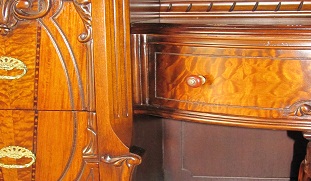Pigment Stain Versus Dye Stain
Basic info on the characteristics that differentiate dyes from pigments, and advice on the appropriate uses of each (separately or together). June 28, 2013
Question
What is your take on pigment stains vs. dye stains? I know that some stains use both. I am trying to figure out when to use which one to get the final colors I am trying to match. We are working on matching our own stains in house as the suppliers are charging so much for the mixed stains that it is just becoming cost prohibitive. So far it has been working nicely but just need some more direction.
Forum Responses
(Finishing Forum)
From contributor J:
There are lots of variables to take into consideration when using dyes or pigment stains. Most common is to dye the wood first, then apply pigment. Though one firm I worked with preferred to add dye the MLC's Woodsong stains as a short-cut to save time and labor. Dye stain can also be added to you finish lacquer as in Microtoners from MLC too! Not all woods benefit from dye stains. The choice is yours by experimenting and developing sample boards.
From contributor B:
Pigment stains have very, very finely ground solids in them, and as such, are more likely to obscure grain. That doesn't mean that they necessarily will obscure grain, just that multiple coats can obscure the grain.
Dyes, on the other hand (which can be sold in either powder or liquid form), once properly dissolved in water, alcohol, or other solvent, are completely liquid and are translucent when applied. The dye is sealed, and a subsequent coat(s) of the same or a different shade of dye stain can be applied without ending up with a "muddy" look. If you apply multiple coats of pigment stains you can end up with a muddied look, in addition to obscured grain. For this reason obtaining the right color is often (if not usually) a multi-step process.
The base color is established with an application of dye stain (or stains), which are then sealed. Then pigment stains can be applied to get you to (or close to) the final color. Once sealed, this color can then be finished, or tweaked with toners and/or glazes.
From contributor F:
It really depends on your skill level and the look you are trying to achieve. There are some finishes that simply cannot be duplicated without using one or the other, or a combination of both. One big advantage to dyes is you are not limited in the number of coats that can be applied, at least theoretically speaking. A properly reduced and sprayed dye can be built-up, coat after coat and not obscure the grain whereas the much larger size of the colorant in pigment stains will muddy the grain quickly if too much is left on the surface, as well as causing drying and adhesion problems.
Dyes are great for making figured woods pop and building deep dark colors without having to leave excess pigment stain on the wood. Pigment stains are better at ticking and coloring the pores of the wood and generally require less skill to use than dyes.
From contributor R:
The other thing that dyes will do: create that golden highlight that nothing else will. An amber shade can come close sometimes, but an aniline dye is magical. Oil-borne aniline dyes are more lightfast (resistant to sun fade). Alcohol-based anilines must be sprayed because they dry almost instantly, and you cannot see how it will look until it is coated with sealer, or another clearcoat of your choice, so your sample testing is critical. Correct about doing the dye first, then build your color on that in translucent steps. Oil-based paste wood filler, (pore filler) is an essential but often overlooked step in the process. It comes as thick as axle grease, and must be reduced with mineral spirits. Note: I am old school, and will not use anything but an oil-based PWF.
From contributor C:
We work mostly on older furniture and begin our color process with a dye 90% of the time to set a base or background color - greater transparency, deeper colors, and more conducive to chatoyance. After sealer, often pigment stain to touch the pores if pore-filler is not in the equation. After more sealer use glazes, shaders, and toners as needed to dial in the look.

From contributor U:
Quite a question. I've been a finish artisan for 30 years, and what everyone is saying is true. Youíre getting technical information here on what pigment will do over dye. I think you seem to be at the point where this information is already knowledge. I will say this much, we keep a large inventory of pigments, dyes, glazes, paints (yes, paints can also be used in different application methods to change tones and shades of wood on transparent finishes), toners, etc.
Depending on the finish you are matching all or some may be applicable ranging from base color tones to the more exotic multi layered finishes. Itís all in the project at hand and the scope of your clientele. No amount of information aside from mixture knowledge will lessen the need for samplings. To answer your question from experience - both!
